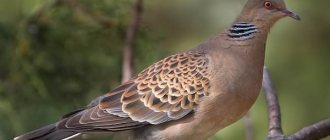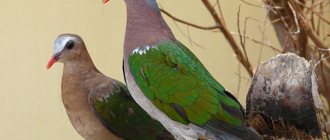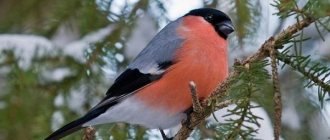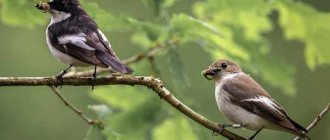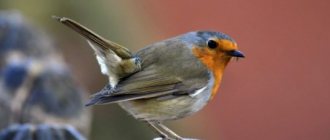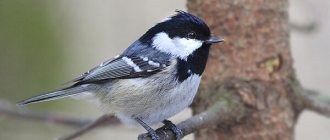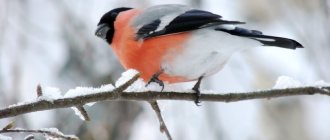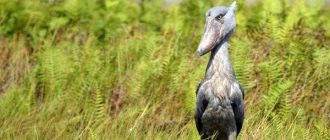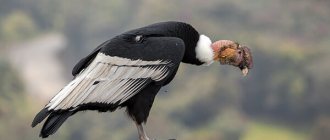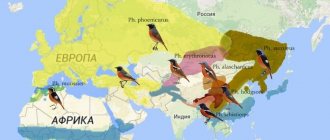Description of the bird
The body length of the turtle dove is from 25 to 28 cm. The head is round, slightly elongated, and goes into the neck in a smooth, curved line. The eyes are located in the center of the head, and their color always matches the color of the plumage. For example, brown doves have orange eyes, white doves have reddish eyes, and pied doves have black irises. The eye rings are pink. The beak is of medium length, dark in brown individuals, and beige in light ones. The neck is short, with a ring-shaped pattern. The wings are rounded.
— Advertising —
The plumage of adults is creamy-grayish in color, the folded wings are light red with black spots, the tail is dark gray, almost black, with a white stripe. There are black and white spots on the sides of the neck. Paws are pink. Males are slightly larger than females. Young birds are feathered in the same way as adults, but they are not so bright, without spots on the sides of the neck; Their iris is brown and their legs are brown.
Natural enemies of the turtle dove
Photo: What an eagle looks like
Under natural conditions, turtle doves live for about 6-7 years and most often die in the claws or jaws of predators.
They have many enemies:
- almost all birds of prey;
- foxes, dogs, cats and other predators that can hunt both adults and young animals and destroy nests.
Some species of doves are subject to hunting. A large number of chicks die in the first week after birth. They often fall out of their nests, and since they cannot fly, they become someone’s prey and their parents cannot help them in any way. It is precisely because of the low survival rate of young animals that many turtle doves carry out not one, but several clutches per season.
Man can also be called the enemy of these birds of paradise. For many decades, some species of doves have been subject to active traditional hunting, especially in their wintering areas, where they arrived in large numbers. Human economic activity also has a negative impact on their population. The fields are treated with various chemicals, and since grain is part of the usual diet of these birds, they are the first to suffer.
Interesting fact: In artificially created conditions, turtle doves can live up to twenty years of age and regularly give birth.
What does it eat?
Turtle doves feed on the seeds of a variety of plants and trees (pine, spruce, birch, alder), as well as berries, small mollusks and insects. During warm spring and summer periods, birds look for food in meadows, along river banks, and in autumn - in fields of wheat, hemp, buckwheat, and millet. In this case, the birds do not peck the grains from the ears, but collect them on the ground. In sunflower crops, turtle doves peck seeds from the baskets. Thus, on the one hand, turtle doves are useful because they destroy weed seeds, and on the other hand, these birds can harm agricultural crops.
Lifestyle
The turtle dove's habitat is large; different species can be found all over the world. The main nesting places for turtle doves are northern Africa, Asia, Kazakhstan; a common species can also be observed in western Siberia. Birds settle both in coniferous and deciduous forests (in the northern regions), and in dense coastal bushes.
Attention!
The common turtle dove is a migratory bird; during cold months it prefers to settle in equatorial Africa and the Sahara. Ringed - for the winter it remains in its permanent nesting areas.
In describing the turtle dove, in particular, its habitats, it is interesting to mention another difference between the species. The ringed variety, unlike other relatives, willingly nests in the vicinity of a person, as if seeking his protection. Birds delight with their iridescent singing in city parks, gardens and villages.
Songbirds feed on grains, plant seeds, and readily eat bread crumbs. A relative of the pigeon flies low, quickly turns its head, looking for food on the ground. Basically, the bird picks up food near its nest. Pieces of food are not eaten immediately, but are “stored” in the crop. Only after filling it completely does it fly away to a quiet place and swallow it piece by piece.
Kinds
Common turtle dove (Streptopelia turtur)
The bird's body length is from 26 to 29 cm, its weight reaches 300 g. The back is red-brown and black. The sides are black and white, the belly is white, the chest has a reddish tint. Sexual dimorphism is not typical. The voice consists of the sounds “turr-turr”.
The species is migratory; from May to September it lives in Europe and winters in Africa.
Little dove (Streptopelia senegalensis)
It lives in tropical Africa, the Middle East, India and western Australia. The body length of the species is from 26 to 29 cm, the wingspan is from 40 to 43 cm. The weight of adult birds is in the range of 90-130 g. The tail is long. The plumage is reddish-brown with a bluish-gray tint on the wings and tail. The head and belly are light, there are dark spots on the neck. Legs are red. Sexual dimorphism is not typical. Juveniles have a reddish tint to their plumage, yellow irises and a red beak. Adults have gray beaks and eyes.
Wild Laughing Dove (Streptopelia roseogrisea)
The body length of this species is up to 30 cm. The plumage on the back is light beige. The wings are grey-brown and dark. On the back of the head there is a thin black stripe that continues to the middle of the neck. The neck and chest are light beige, the belly and sides are white. The paws are red, the beak is dark gray.
The species breeds in Africa from Mauritania to Somalia, as well as in the southwest of the Arabian Peninsula.
Madagascar dove (Nesoenas picturata)
Found in Madagascar, Mauritius, Reunion, Comoros and Seychelles. The bird's body length is up to 28 cm. The tail is short, the legs are long. The shoulders are red-brown, the back is dark brown, the belly is light brown, the head is bluish-gray. There are brown spots on the sides of the neck. The wings are dark brown, the undertail is white. The bill is bluish-gray at the top and purple at the base. The iris is red-brown, the eye ring is purple.
Great Dove (Streptopelia orientalis)
The body length is about 30 cm, the plumage is brown on the back, with a pinkish tint on the belly. The tail is black with a white stripe along the edge. Neck with black and white stripes. The iris is light red, the beak is brown, the paws are reddish.
The great turtle dove lives in mixed and deciduous forests, as well as in city parks and villages. The bird often chooses places to live near humans. The species is widespread in Asia, from the Urals to Sakhalin and the Sea of Okhotsk, and in Europe, except for the countries of Scandinavia.
Ringed Dove (Streptopelia decaocto)
The body length reaches 33 cm. The wingspan is from 47 to 55 cm, the weight of adult birds is from 150 to 200 g. The plumage is light, beige-brown, with dark feather tips, the head and tummy are lighter than the rest of the body. The iris is reddish, the ocular ring is white. There is a black open ring on the back of the head. Sexual dimorphism is not observed. Young individuals do not have a black half-ring on the back of the head.
From Western Asia and the Balkan Peninsula, the species was distributed throughout Europe and Central Asia. Often found near people's homes.
Spotted Dove (Streptopelia chinensis)
The species' habitat includes southern and southeastern Asia. Body length up to 27.5 cm, weight about 150 g. Females are slightly smaller in size than males. The wings are short, the tail is long. The head and belly are light gray-pink in color, the forehead is light, and the back of the head has a reddish tint. The back, wings and tail are light brown with speckles. A wide dark stripe with white spots runs along the neck. The wing coverts look like scales, as the feathers have a light brown border.
Lifestyle and habitat
The habitat depends on the type of dove. It has already been said that the spotted pigeon is Asian, the blue pigeon is American, and the diamond pigeon is Australian by birth. Doves from their northern habitat fly to Africa for the winter. There, most birds settle in the Sahara and Sudan. Pigeons from warm places lead a sedentary lifestyle.
Some turtle doves settle in attics and parks, while others climb away from people, into forests. By the way, most members of the family prefer deciduous forests. Mixed - a reserved option for doves from the northern territories. Birds do not settle in purely coniferous forests.
Ringed dove in the nest
In addition to full-fledged forests, turtle doves recognize thickets of bushes. The main thing is that there is a source of water nearby. Doves hide nests in vegetation. If the species is migratory, its representatives return to their breeding grounds in late April, early May.
Flights are made in groups of about 2 dozen individuals. Doves are removed from their homes in mid-August and early September. The exact dates depend on the breeding regions. Northern birds fly away earlier.
Reproduction
The nesting season of the turtle dove is long, while some pairs are already hatching chicks, the rest are starting to build a nest.
Mating season
During the mating season, the male cares for the female and emits a gentle monotonous cooing sound, which consists of “tur-tur” sounds. At the same time, the male’s neck inflates and his head drops. Between pleasant coos, the male also makes a light clicking noise.
Nest
Doves nest on forest edges, in parks, forest belts and plantings. They build a nest from brushwood, plant roots, on tree branches, and less often in bushes.
Laying eggs
In one clutch, a female turtledove has two white or cream-colored eggs. The incubation period lasts from 13 to 16 days. Both partners take part in incubation.
Chicks
Parents protect and protect the chicks; they do not leave the nest even in danger. The chicks begin to fly by the end of the 3rd week of life, and quickly become independent. After this, they leave the nesting area and form independent flocks of 7-10 individuals. In the southern regions of their distribution, turtle doves manage to make 2 clutches during the summer.
Interesting Facts
The half-ring, which is considered the main distinguishing feature of this species, appears on the neck of adult individuals. It does not occur in young animals. The ringed dove is considered a relative of the pink pigeon, recognized as one of the largest and rarest representatives of this family. A little over ten years ago, there were about twenty individuals of this species in the world. To preserve the pink pigeon population, scientists had to develop an entire program, thanks to which people managed to revive the endangered population.
Where do beautiful feathered creatures live longer?
Due to their calm nature, endurance and unpretentiousness in food, turtle doves live longer in captivity . Suitable housing for them:
- Pet stores.
- Zoos.
- National parks.
- Spacious cells.
- Spacious and high enclosures.
It is important that they live as a couple or family, otherwise living alone threatens their death.
